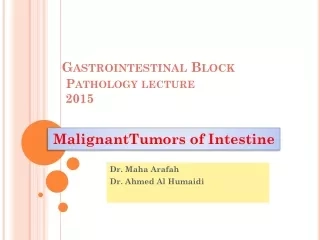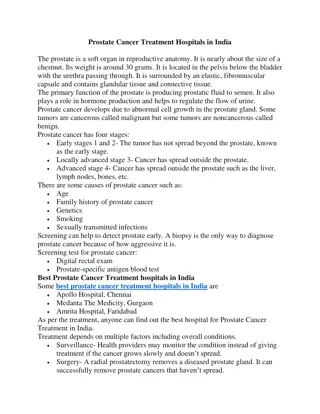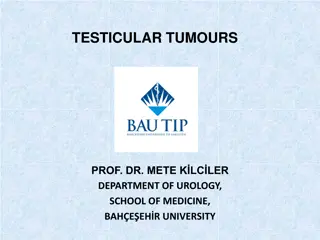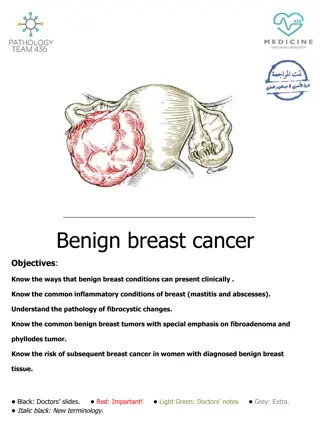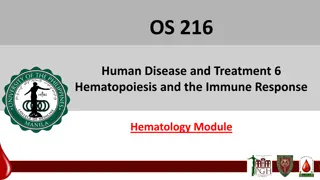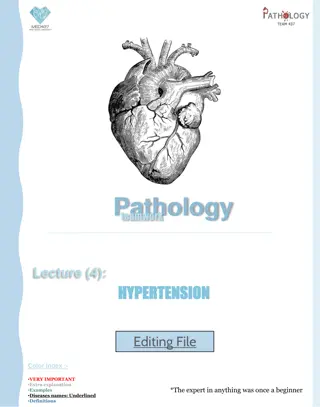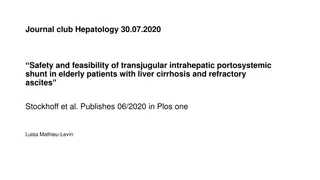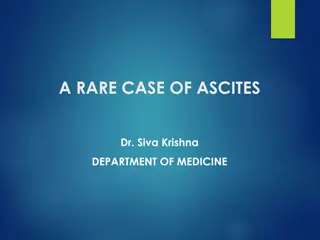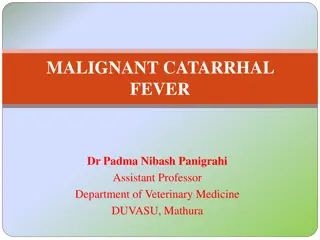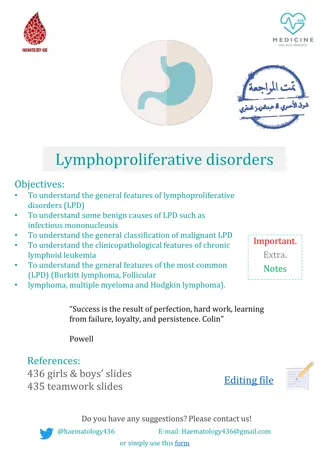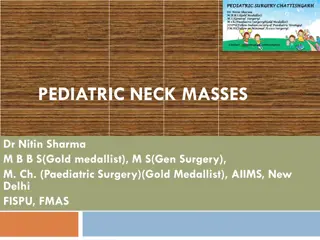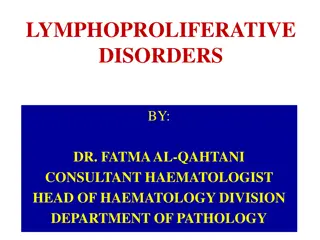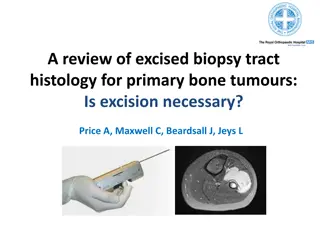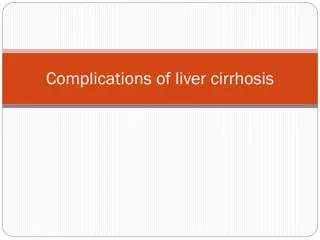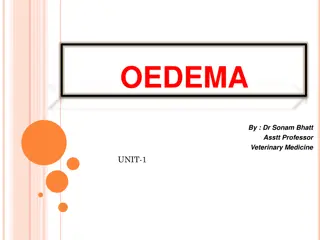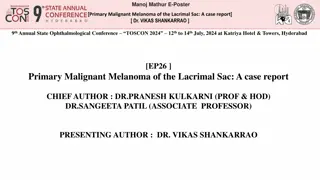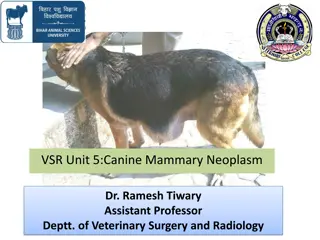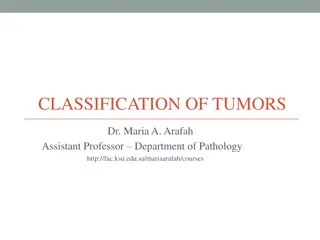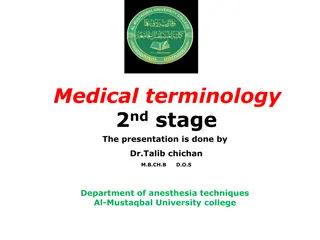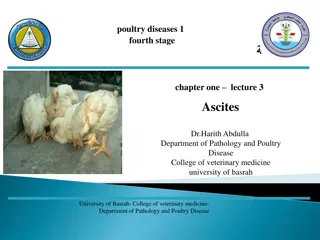MalignantTumors of Intestine
This lecture discusses the epidemiology, pathology, and prognosis of malignant tumors of the intestine, with a focus on colon cancer. It covers the different stages of colorectal adenocarcinoma, the relationship between CEA and recurrence, and the significance of carcinoid tumors.
3 views • 40 slides
Understanding Tumor Classification and Nomenclature in Pathology
This slideshow provides an overview of tumor classification, nomenclature, and key concepts in pathology. It covers the definitions of neoplasm, tumor, and oncology, the classification of tumors into benign and malignant categories, as well as the importance of stroma in tumor behavior. It also expl
2 views • 61 slides
Best Prostate Cancer Treatment Hospitals in India
The prostate is a soft organ in reproductive anatomy. It is nearly about the size of a chestnut. Its weight is around 30 grams. It is located in the pelvis below the bladder with the urethra passing through. It is surrounded by an elastic, fibromuscular capsule and contains glandular tissue and conn
1 views • 2 slides
neurosurgeon in jaipur-Dr Himanshu Gupta
brain tumor is an abnormal growth of cells in the brain. Tumors can be either cancerous (malignant) or non-cancerous (benign). Cancerous tumors grow and spread aggressively, potentially invading nearby tissues and spreading to other parts of the body, while non-cancerous tumors are usually less aggr
0 views • 5 slides
Understanding Malignant Melanoma: Types, Signs, and Prognosis
Malignant melanoma is a serious skin cancer with various types, including superficial spreading, nodular, acral lentiginous, lentigo maligna, and amelanotic. Recognizing early signs such as ABCDEF (Asymmetry, Borders, Colour, Diameter, Evolving, Funny-looking) is crucial for prompt diagnosis. Macros
1 views • 25 slides
Understanding Testicular Tumors: Types, Classification, and Clinical Findings
Testicular tumors are predominantly malignant, with germ cell tumors being the most common type. This article delves into the classification of testicular tumors, including primary and secondary, benign and malignant, germ cell, and non-germ cell tumors. Clinical findings such as painless enlargemen
3 views • 31 slides
Understanding Grading and Staging of Malignant Tumors in Cancer Patients
Grading and staging are crucial in determining the aggressiveness and extent of malignant tumors. Grading involves assessing the level of malignancy based on cell differentiation and mitotic activity, while staging considers the size of the tumor, lymph node involvement, and presence of metastases.
7 views • 31 slides
Understanding Benign Breast Conditions: Clinical Presentations and Pathology
Benign breast conditions can manifest in various ways, including pain, palpable masses, and nipple discharge. Familiarity with common inflammatory conditions like mastitis and abscesses, as well as understanding fibrocystic changes and benign tumors such as fibroadenoma, is crucial. Mammographic scr
0 views • 15 slides
Understanding Emergency Psychiatry: Critical Insights and Interventions
Explore the essentials of emergency psychiatry through insights into psychiatric emergencies, including neuroleptic malignant syndrome and serotonin syndrome, as well as emergencies of suicidality. Learn about assessment tools and resources for managing behavioral health crises effectively.
0 views • 16 slides
Comprehensive Overview of Hematopoiesis and Immune Response in Human Disease and Treatment
This 1-week course delves into the pathophysiology, diagnosis, and treatment of diseases affecting the Hematopoietic System. Topics covered include benign and malignant hematologic disorders, pediatric and adult presentations, blood component therapy, transfusion medicine, and more. Faculty units fr
0 views • 20 slides
Nutritional Considerations for Chronic Liver Disease in Critical Care
Malnutrition is common in chronic liver disease, leading to complications such as ascites and infections. Sarcopenia and weight loss are prevalent regardless of BMI. Critical care patients with liver disease face challenges due to limited physiological reserve, with main causes for ICU admission bei
1 views • 17 slides
Understanding Laryngeal Tumours: Types, Classification, and Pathology
Laryngeal tumours can be benign or malignant, with different types such as papilloma, chondroma, paraganglioma, and squamous cell carcinoma. These tumours present with various symptoms and may spread through direct, lymphatic, or hematogenous routes. Risk factors include tobacco smoking, alcohol con
0 views • 24 slides
Enhancing FISH Analysis Sensitivity with Highly Purified Multiple Myeloma Cells
FISH analysis is crucial in multiple myeloma diagnostics, but challenges arise due to low plasma cell detection rates. By isolating CD138+ malignant plasma cells with the EasySep system, sensitivity can be improved for more accurate genetic aberration detection in cytogenetic analyses, aiding in pat
1 views • 12 slides
Understanding Hypertension: Causes, Classification, and Complications
Hypertension, a common yet serious health issue, is explored in detail in this lecture. The etiology, risk factors, and complications of hypertension are discussed, along with the classification into primary, secondary, benign, and malignant hypertension. The lecture also covers causes of secondary
1 views • 13 slides
Safety and Feasibility of TIPS in Elderly Patients with Liver Cirrhosis
Challenging liver cirrhosis management in elderly patients with refractory ascites has high mortality rates, and transplantation is not always viable. Transjugular intrahepatic portosystemic shunt (TIPS) serves as a non-curative treatment option, aiming to reduce portal hypertension. The procedure i
0 views • 17 slides
Neuroleptic Malignant Syndrome and Serotonin Syndrome Overview
This educational material provides an in-depth understanding of Neuroleptic Malignant Syndrome (NMS) and Serotonin Syndrome (SS) including their background, pathophysiology, clinical characteristics, differential diagnosis, risk factors, and treatment approaches. It also explores the historical back
3 views • 53 slides
A Rare Case of Ascites in a 22-Year-Old Female: Clinical Presentation and Investigations
A 22-year-old female presented with abdominal distension and pain. Her medical history, family history, and personal habits were reviewed. Examination revealed mild hepatomegaly and shifting dullness. Lab investigations showed normal values with no signs of infection. Ascitic fluid analysis indicate
1 views • 20 slides
Overview of Malignant Catarrhal Fever in Cattle and Other Species
Malignant catarrhal fever (MCF) is a fatal disease affecting various species, caused by two different viruses transmitted from wild animals. It is characterized by low morbidity but high mortality rates, with distinct clinical signs such as sudden death, head and eye manifestations, and intestinal i
0 views • 24 slides
Understanding Lymphoproliferative Disorders and Their Features
Explore the general features of lymphoproliferative disorders, including benign causes like infectious mononucleosis and the classification of malignant LPDs. Delve into chronic lymphoid leukemia, along with common LPDs such as Burkitt lymphoma, Follicular lymphoma, multiple myeloma, and Hodgkin lym
0 views • 8 slides
Understanding Cancer: Causes, Symptoms, and Prevention
Cancer is a disease characterized by the uncontrollable growth and spread of abnormal cells in the body. These cells form tumors that can be either cancerous (malignant) or non-cancerous (benign). Cancer can develop in various parts of the body and is often caused by genetic changes that affect cell
2 views • 21 slides
Comprehensive Overview of Parotid Tumor Diagnosis and Management
This comprehensive guide covers the diagnosis and management of parotid tumors, including anatomy, differential diagnosis, and management strategies. It discusses the approach to evaluating patients with neck lumps, differential diagnoses to consider, and the management techniques for both benign an
0 views • 20 slides
Pediatric Neck Masses: Causes and Anatomy Explained by Dr. Nitin Sharma
Learn about pediatric neck masses, their causes including congenital, inflammatory, and malignant factors, and the embryology and anatomy behind them. Detailed insights are provided on the branchial system, its arches, pouches, and the structures they contribute to in the neck. Dr. Nitin Sharma, a h
0 views • 42 slides
Approach to a Thyroid Nodule: Causes, Diagnosis, and Management
When encountering a thyroid nodule, it is essential to consider both benign and malignant causes. Clinical features may vary, and investigations such as ultrasonography, FNAC, and thyroid scanning play crucial roles in evaluation. Understanding the findings suggestive of malignancy is key for approp
0 views • 32 slides
Understanding Lymphoproliferative Disorders: A Comprehensive Overview
Lymphoproliferative disorders encompass various clinical conditions involving the excessive production of lymphocytes, such as lymphoma and lymphoid leukemia. This article delves into the definitions, causes, and specific types of lymphoproliferative disorders, including infectious mononucleosis and
0 views • 27 slides
Excised Biopsy Tract Histology for Primary Bone Tumours: Necessity of Excision Examined
Investigating the necessity of excising biopsy tracts in primary bone tumours, this study analyzed 278 patients over a span of two years. Findings indicated conflicting evidence regarding the risk of malignant seeding in biopsy tracts, with only one patient showing histological evidence of seeding.
0 views • 14 slides
Understanding Complications of Liver Cirrhosis
Recognize major complications of liver cirrhosis including hepatic failure, portal hypertension, ascites, hepatorenal syndrome, and esophageal varices. Learn about the pathogenetic mechanisms, clinical features, and pathological findings associated with these complications.
0 views • 30 slides
Understanding Complications of Liver Cirrhosis
Learn about the major complications of liver cirrhosis, including portal hypertension, hepatic failure, ascites, spontaneous bacterial peritonitis, and more. Explore the pathogenetic mechanisms, clinical features, and pathological findings associated with these complications, and understand the impa
0 views • 31 slides
Understanding Oedema in Veterinary Medicine
Oedema is the abnormal accumulation of fluid in tissues and cavities, often caused by factors like decreased plasma oncotic pressure, increased hydrostatic pressure, increased capillary permeability, or lymphatic flow obstruction. This article explores the etiology, pathophysiology, and clinical sig
0 views • 17 slides
Differential Diagnosis of Ascites in a 50-Year-Old Man with Liver Disease
Ascites, jaundice, and confusion in a 50-year-old man raise concerns about liver disease. Differential diagnosis includes cirrhosis, malignancy, alcoholic liver disease, and biliary obstruction. Physical examination findings such as spider naevi, hepatomegaly, and asterixis help narrow down the poss
0 views • 45 slides
Management of Malignant Ascites in Advanced Cancer: ESDO Learning
Malignant ascites is a challenging complication of advanced cancer, impacting patient quality of life and survival. Diagnosis involves imaging and cytology, with poor prognostic indicators. Management includes symptom relief with diuretics, paracentesis, and catheter options. Refractory cases presen
0 views • 7 slides
Understanding Malignant Hyperthermia: Causes, Management, and Epidemiology
Malignant Hyperthermia (MH) is a genetic disorder of skeletal muscle triggered by certain anesthetics, leading to a hyper-metabolic state. The uncontrolled release of calcium results in muscle rigidity, metabolic acidosis, hyperthermia, and other serious complications. MH was first described in the
0 views • 24 slides
Primary Malignant Melanoma of the Lacrimal Sac: A Rare Case Report
Malignant melanoma of the lacrimal sac is a rare condition that poses challenges in early diagnosis due to its insidious onset. This case study discusses the presentation, diagnosis, and treatment of a 78-year-old woman with a palpable mass in the lacrimal sac, highlighting the importance of early i
0 views • 6 slides
Canine Mammary Neoplasms: Overview and Management by Dr. Ramesh Tiwary
Canine mammary neoplasms, including benign adenomas and malignant carcinomas, are common in intact female dogs. This article discusses the clinical signs, diagnosis methods like FNAC and biopsy, WHO clinical staging system, and the importance of palpating regional lymph nodes for prognosis assessmen
0 views • 15 slides
Classification of Tumors: A Comprehensive Overview
Understanding the classification of tumors is crucial in the field of pathology. This detailed overview covers the definitions of neoplasia and tumors, the differentiation between benign and malignant tumors, nomenclature, and characteristics of various tumor types. It discusses the behaviors of ben
1 views • 34 slides
Comprehensive Overview of Medical Terminology in Gastrointestinal System
This content provides a detailed exploration of medical terminology related to the gastrointestinal system. It covers definitions, word roots, combining vowels, suffixes, and prefixes commonly used in this medical field. The material includes information on anatomical terms such as anus, appendix, c
0 views • 18 slides
**Understanding Portal Hypertension: Causes, Symptoms, and Treatment**
Portal hypertension is a serious condition often associated with cirrhosis. Causes include cirrhosis and non-cirrhotic conditions. Symptoms range from asymptomatic to complications like variceal hemorrhage, ascites, and splenomegaly. Preventive measures, such as nonselective beta-blockers, are cruci
0 views • 14 slides
Malignant Melanoma of Left Eye Lower Lid - Case Presentation
A rare case of malignant melanoma affecting the lower lid of a 50-year-old female is discussed in this e-poster. The lesion, with characteristic pigmentation and irregular borders, was successfully diagnosed through incision biopsy and histopathological examination. The patient underwent wide excisi
0 views • 6 slides
Ascites in Broiler Chickens: Causes, Symptoms, and Management
Ascites is a common disease in broiler chickens, especially at high altitudes. It is characterized by fluid accumulation in the peritoneal cavity or pericardial sac, often containing yellow protein clots. Predisposing factors include reduced ventilation, high altitude, and respiratory disease. Sympt
0 views • 13 slides
Overview of Renal Tumors: Benign and Malignant Forms
Explore the spectrum of renal tumors, from benign papillary adenomas and oncocytomas to malignant renal cell carcinomas like clear cell carcinoma. Images and descriptions showcase the gross pathology and histopathology of these tumors. Learn about the features and prognosis of different renal tumor
0 views • 31 slides
Non-Malignant Haematology Clinical Trials at Hammersmith Hospital: Latest Research Updates
Explore the latest updates from the Non-Malignant Haematology Clinical Trials Unit at Hammersmith Hospital, including studies on Red Cell Disorders and the REDRESS trial for severe sickle cell disease. Learn about ongoing trials, inclusion criteria, and contact information for participation.
0 views • 11 slides
